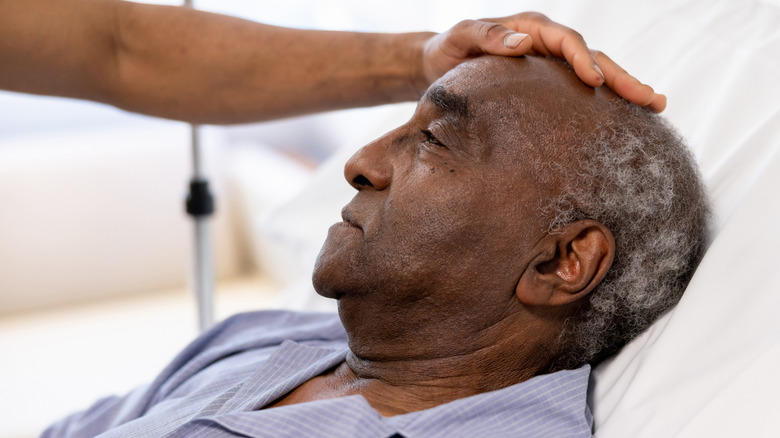Tell-Tale Signs A Person Is In Pain At The End Of Life
Pain is a chief concern frequently voiced among patients nearing the end of life, according to a 2020 study published in BMC Palliative Care. Depending on a person's health status, some people may be more susceptible to pain during the dying process than others. Such may be the case if a person is dying of a particular illness or disease, such as cancer. Research has shown that 64% of advanced-cancer patients report being affected by pain. Health issues related to cognition, however, such as dementia, have been linked with lower rates of reported physical pain.
Pain experienced specifically within the months prior to one's passing has also been the subject of scientific research. Findings of the 2020 study found that fewer than 1 in 5 people in Canada experience severe pain during their last month of life. Conversely, an alternate 2010 study published in Annals of Internal Medicine found that 60% of patients with arthritis experienced pain within the month before their passing. These findings further demonstrate the influence of health conditions on pain toward the end of life.
Unlike a wound or a scar, pain isn't something we can see with our own eyes. Therefore, we must rely on other indicators that can help us determine whether a dying person may be experiencing physical discomfort and how we may help ease that pain.
Pay attention to a dying person's body language
In some cases, a dying person may be able to vocalize that they're experiencing pain. If not, take note of their body language. If the person grimaces, moans, stiffens, tightens their fists, or clenches their teeth — particularly if this occurs while you're attempting to shift or reposition them — then these are indications the person may be in pain, according to experts at the Hospice Foundation of America. Additional non-verbal signs may include frowning, fidgeting, deep breathing, crying, sighing, or a facial expression that communicates fear, per Hospice Red River Valley.
In addition to (or instead of) physical pain, a person may also be in mental or emotional pain towards the end of their life. Such pain may present in the form of nightmares, nervous laughter, irritability, crying episodes, anger, boredom, anxiety, or more. For verbal patients, these kinds of emotions may be indirectly expressed with statements like "nobody cares" or other sentiments of doubt, cynicism, apathy, or distrust, amongst other feelings.
Pain relief methods for people who are dying
When tending to a dying person's physical pain, setting up a system of communication can help caregivers better understand what means of pain management or treatment the person may be in need of. The more specific the terms, the better. Pain descriptors such as sharp, dull, throbbing, burning, constant, or shooting are effective examples, states Hospice Red River Valley. Verbal patients may wish to use these words themselves, or caregivers may offer these words as prompts for patients who communicate non-verbally. Using terms such as these that provide insight into the duration or severity of the pain can also help caregivers track pain progression or improvement.
End-of-life pain treatment methods often involve medication. Depending on the cause and severity of pain, patients may be given over-the-counter (OTC) medications such as acetaminophen or NSAIDs, or may alternatively be given opioid analgesics under careful monitoring by a medical professional, according to 2023 research published in StatPearls. Mental health counseling, spiritual counseling, or acupuncture may also prove helpful. Caregivers can also help prevent the development of pain during the end of life by regularly repositioning individuals who are bed-bound as well as maintaining proper patient dental care.



